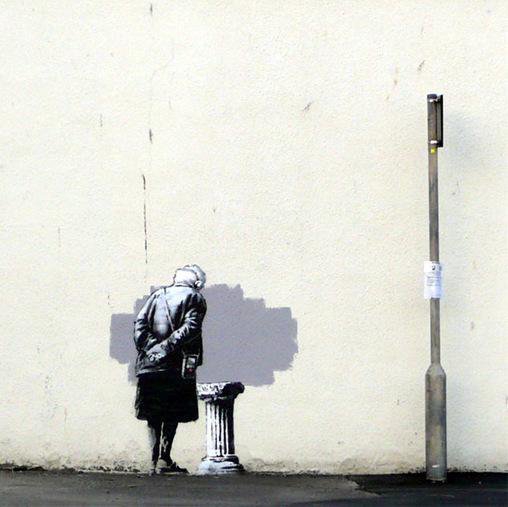I admit I don’t spend too much time in my ArtReview writings discussing the merits of Banksy, Britain’s best-loved graffti artist and comedy situationist. But since September, the art of Banksy has become something of a preoccupation for the citizens of my seaside hometown of Folkestone. At the end of September, with the town’s contemporary-art Folkestone Triennial in full swing, the wall of a local amusement arcade became the site for Banksy’s latest work of unsolicited muralism, Art Buff. Greeted with enthusiasm by locals and the local press, the image, of an old lady dutifully listening to an audioguide while looking down at an empty plinth, was soon covered with a sheet of acrylic, apparently to protect the masterpiece from some less-than-complimentary graffiti. But on the closing weekend of the Triennial in November, residents woke to discover an out-of-town building crew diligently and professionally cutting Art Buff, bricks, mortar and all, out of the wall of the arcade.
The expert removal of Art Buff was the doing of sometime celebrity photographer and now art dealer Robin Barton, the latest of a number of removals of Banksy works that Barton has then gone on to sell privately. Art Buff, Barton explained to irate local artists and the press, would be shipped off to Miami, to be auctioned, the proceeds to benefit a cancer trust established by the owners of the arcade, inheritors of recently deceased local amusement property tycoon Jimmy Godden. Art Buff did turn up in Miami, but not at auction, appearing on the stand of Hamptons-based New York street-art gallery Keszler Gallery. At time of writing, it’s still for sale on the gallery’s website.
Art Buff turns out to be a hipster variant of the ‘Emperor’s new clothes’ complaint against contemporary art, in which gullible ordinary people (the old lady) are told by the powerful (the ‘official’ artworld, represented by the plinth) that there is something meaningful to see where there isn’t. Squarely aimed as pithy critique of the urban-regeneration-and-art jamboree that is the Folkestone Triennial, Art Buff missed its mark, since this year’s Triennial (curated by Lewis Biggs) comprised works that were pointedly didactic and self-consciously accessible to a nonspecialist public, to a generally positive public response.
But Banksy has a habit, by now, of producing images that, while dressed in the garb of ‘edgy’ street art, are really very conformist. Conformist in the sense that whoever Banksy might be, their opinions tend to articulate the current political and cultural views of educated urban liberals. As The Guardian’s Jonathan Jones put it, Banksy’s ‘glib satire is typical of his instinct for trendy political content to impress his bourgeois public. Homing in… on a widely discussed issue, Banksy addresses not the teenagers who used to be graffiti’s users, but – if I may – Guardian readers.’
By October, however, Jones’s spinning opinion-compass was back to defending Banksy’s profound political insights, lamenting the obliteration, by the local council in Clacton-on-Sea following complaints of ‘racism’, of another mural, this time satirising the supposedly anti-immigrant attitudes of local people; five dumpy grey pigeons holding up placards declaring ‘migrants not welcome’, ranged against a solitary, colourful ‘foreign’ bird. ‘This is the best Banksy I have never seen,’ declared Jones, metaphysically.
The work’s obvious contempt for the ‘provincial’ attitudes of dullard, ordinary folk isn’t exactly subtle. But then such street art was only really ever speaking to a cultured, metropolitan public, which is why it has become a hit with art collectors. As Keszler Gallery’s Stephen Keszler declared haughtily to Folkestone’s local paper, Banksy’s work is for ‘people with taste and money’, adding that ‘every complainer would stop complaining if Banksy would paint on their property’.
Perversely, the habits of art market exclusivity, social hierarchy and artworld cultural elitism reproduce themselves in the supposedly demotic space of street art
Maybe. But for the time being, the ‘people with taste and money’ are keen to keep it for themselves. Local authorities, meanwhile, tend to play into the hands of this odd market for bricks by fretting about its potential market value. And local opinion – barring the occasions where Banksy’s contempt for locals exceeds even their tolerance – tends to buy into this culture of exclusivity, petitioning, as they did in Folkestone, for the return of ‘our Banksy’.
So, perversely, the habits of art market exclusivity, social hierarchy and artworld cultural elitism reproduce themselves in the supposedly demotic space of street art. There’s a simple solution to all this, though. Since there are no intellectual property rights at stake (who knows who Banksy is?), we’re at liberty to copy these murals as much as we like, even if we think they’re terrible. Make every wall a canvas for everyone or not at all. Or to stop these images from entering the closed circuit of private consumption, paint over them the instant they appear. Copy. Erase. Just don’t fetishise.
This article was first published in the Jan & Feb 2015 issue of ArtReview
